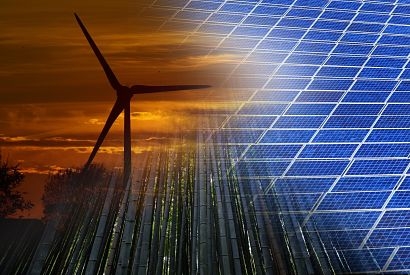
EIA's most recent "Electric Power Monthly" report reveals that renewable energy sources (i.e., biomass, geothermal, hydropower, solar, wind) provided 22.5 percent of US electrical generation during the first four months of 2021. A decade earlier, during the first four months of 2011, renewables provided 13.75 percent of electrical production. Thus, over the intervening years, renewables added - on average - a bit less than one percent annually to their share of the nation's electricity supply.
Almost all the growth can be attributed to wind and solar which expanded from 3.3 percent in April 2011 (year-to-date) to 13.9 percent in April 2021 (YTD). Meanwhile, the share of electrical generation attributable to biomass, geothermal, and hydropower combined has remained virtually unchanged, accounting for between a bit less than 9 percent and a bit more than 10 percent each year.
Should that trend continue, renewables would be on track to provide approximately one-third of US electrical generation in 2030 with wind and solar combined providing about 23 percent and the combination of biomass, geothermal, and hydropower contributing another 10 percent.
For the immediate future, this trend appears to be confirmed by EIA in its most recent monthly "Short-Term Energy Outlook" (STEO) which forecasts utility-scale renewables to grow from 19.8 percent in 2020 to 20.6 percent in 2021 and then to 22.5 percent in 2022. If small-scale solar were to be included, renewables were 20.6 percent of US electrical generation in 2020 and are on track to exceed 21 percent in 2021 and 23 percent in 2022.
FERC's data over the last decade further confirm likelihood of one-third renewables by 2030. However, there are hints in EIA's and FERC's data that renewables' share of electrical generation in 2030 could be larger - perhaps reaching 50 percent.
EIA and FERC data also indicate reaching 80 percent renewables by 2030 remains possible ... but a challenge. Reaching 50 percent renewables by the end of this decade would still remain well short of President Biden's call for 80 percent clean power by 2030 (assuming "clean" means "renewable" and does not include nuclear power or fossil fuels with carbon capture).
However, EIA's historic data also suggest a faster growth track is possible for wind and solar which comes close to Biden's target. Three times during the past six years (2016, 2017, 2020), the annual growth rate for wind-generated electricity has increased by 12.0 percent or more. And, as earlier noted, while averaging only 21.1 percent during the last three years, the average annual growth rate for solar between December 2014 and December 2020 actually surpassed 30 percent (i.e., 31.1 percent).
If these higher growth rates were replicated and sustained each year for the balance of the decade - an admittedly very challenging goal - wind could account for about 25 percent of US electrical generation by 2030 while solar would be nearly 45 percent. Add in another 10 percent from hydropower, biomass, and geothermal and one reaches Biden's 80 percent target.
A national clean electricity standard could make such a scenario - or comparable alternatives - realistic. Yet, even without a national clean electricity standard to drive growth, other factors could still enable renewables to secure a substantially larger share of electrical generating capacity and provide more actual generation than historical trends suggest.
For additional information:

